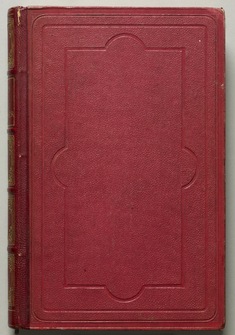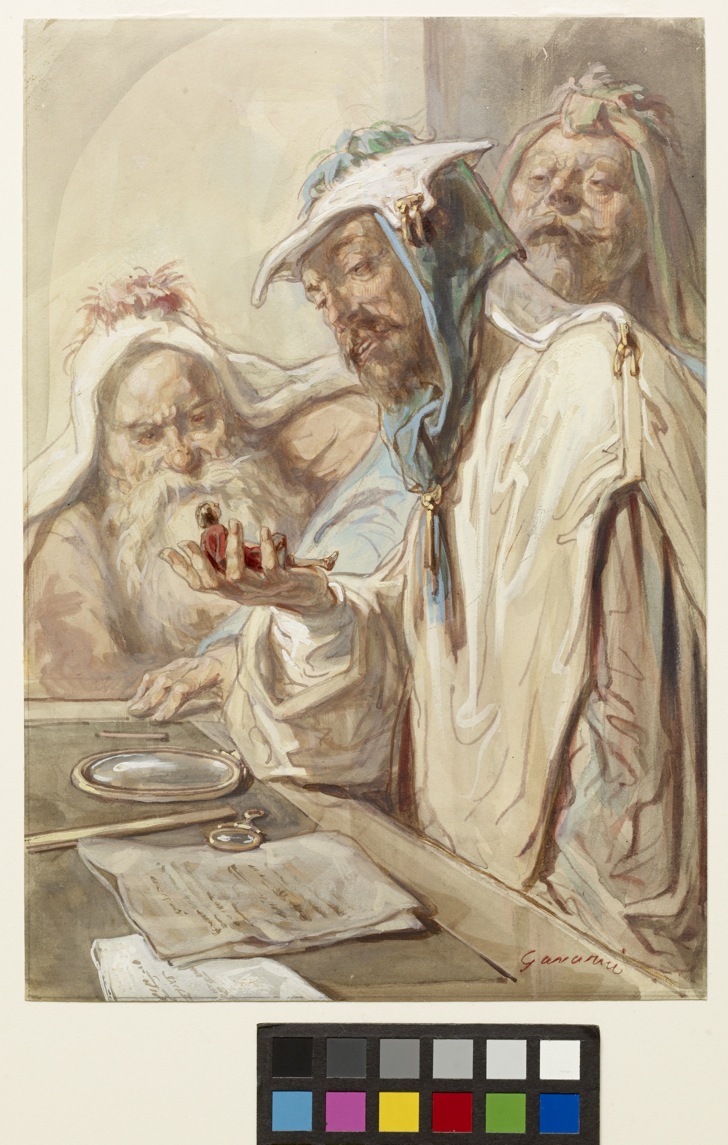Gulliver and the Brobdingnagian Philosophers
(18th and 19th Centuries )
The best-known episode from Swift's "Gulliver's Travels" involves a sojourn amongst the tiny Lilliputians. Subsequently, the hapless Gulliver sails to the island of Brobdingnag, whose inhabitants are as giant as the Lilliputians were tiny. This drawing depicts an episode that Swift uses to satirize the learned conventions of his day. Gavarni accordingly clothes the scholars of the Brobdingnagian court in a parody of the academic robes of his own era.
"His Majesty sent for three great scholars. . . . These gentlemen, after they had a while examined my shape with much nicety, were of different opinions concerning me. They all agreed that I could not be produced according to the regular laws of nature, because I was not framed with a capacity of preserving my life, either by swiftness, or climbing of trees, or digging holes in the earth. They observed by my teeth, which they viewed with great exactness, that I was a carnivorous animal; yet most quadrupeds being an overmatch for me, and field mice, with some others, too nimble, they could not imagine how I should be able to support myself, unless I fed upon snails and other insects, which they offered, by many learned arguments, to evince that I could not possibly do. One of these virtuosi seemed to think that I might be an embryo. . . . But this opinion was rejected by the other two, who observed my limbs to be perfect and finished, and that I had lived several years, as it was manifested from my beard, the stumps whereof they plainly discovered through a magnifying-glass. . . ."
Inscription
Provenance
Provenance (from the French provenir, 'to come from/forth') is the chronology of the ownership, custody, or location of a historical object. Learn more about provenance at the Walters.
William T. Walters, Baltimore, 1870, by purchase [George A. Lucas as agent]; Henry Walters, Baltimore, 1894, by inheritance; Walters Art Museum, 1931, by bequest.
Exhibitions
| 2010 | Great Illustrations: Drawings and Books from the Walters' Collection. The Walters Art Museum, Baltimore. |
| 2005-2006 | The Essence of Line: French Drawings from Ingres to Degas. The Walters Art Museum, Baltimore; Baltimore Museum of Art, Baltimore; Birmingham Museum of Art, Birmingham; Tacoma Art Museum, Tacoma. |
| 1998-1999 | A Discerning Eye: Nineteenth-century Drawings and Watercolors. Academy Art Museum, Easton. |
| 1998-1999 | Botanical Delights: Floral Motifs in 19th-Century Art. Government House, Annapolis; Strathmore Hall Art Center, North Bethesda; Academy Art Museum, Easton. |
| 1997-1998 | French Master Drawings. The Walters Art Gallery, Baltimore. |
| 1983 | A Connoisseur's Portfolio: Nineteenth-century Drawings and Watercolors in the Walters Art Gallery. The Walters Art Gallery, Baltimore. |
| 1979 | A Supple Brush: The Flowering of Continental Watercolors. The Walters Art Gallery, Baltimore. |
Conservation
| Date | Description | Narrative |
|---|---|---|
| 4/20/1979 | Examination | examined for exhibition |
| 1/1/2002 | Treatment | examined for exhibition; mounted; other |
Geographies
France (Place of Origin)
Measurements
H: 9 1/4 x W: 6 7/16 in. (23.5 x 16.4 cm)
Credit Line
Acquired by William T. Walters, 1870
Location in Museum
Not on view
Accession Number
In libraries, galleries, museums, and archives, an accession number is a unique identifier assigned to each object in the collection.
In libraries, galleries, museums, and archives, an accession number is a unique identifier assigned to each object in the collection.
37.1482
Do you have additional information?
Related Objects







